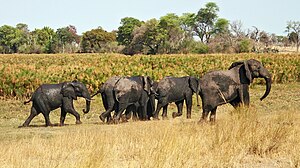Bwabwata National Park
|
Bwabwata National Park
|
|
|
Elephants in Bwabwata |
|
| location | Caprivi Strip , Namibia |
| surface | 6100 km² |
| WDPA ID | 303692 |
| Geographical location | 17 ° 55 ′ S , 22 ° 30 ′ E |
| Setup date | 2007 (1968 or 1986) |
| administration | Ministry of Environment and Tourism |
The Bwabwata National Park (formerly Caprivi National Park and Mahango National Park ) is a national park in Namibia . It extends to almost the entire area of the western Caprivi Strip in Namibia.
In the north and south it is bounded by the Namibian state border ( Angola in the north and Botswana in the south), in the west by the Okavango ( Bagani ) and in the east by the Kwando . To the east, beyond the Kwando, is the Mudumu National Park . It is further subdivided - from west to east - into the areas Mahango Core , Buffalo Core , Bwabwata and Kwando Core . In the core areas, i.e. H. Core areas, the traditional population groups are allowed to continue to live.
The park was proclaimed in 2007 as a merger of the Caprivi National Park and the Mahango National Park. The Caprivi National Park was founded in 1968, the Mahango National Park in 1986. South African troops were stationed here for a long time to pursue rebels in neighboring Angola.
About one seventh of the area of the park has been on the tentative list of Namibia since 2016 as part of a proposal to expand the Okavango Delta World Heritage Site in Botswana to include its inflow and peripheral areas in Namibia .
vegetation
The middle part is completely covered with deciduous forests and is cut through for 180 km by the Trans-Caprivi-Highway . At the eastern end, the park drops into the wide plain of the Kwando. Here the park is accessed by some, albeit very bad, sandy slopes. In the western part, with the exception of the direct shoreline, the vegetation in the park consists of typical dry forest, on the dunes you can find Mukwa ( Pterocarpus angolensis ), Burkea africana and Rhodesian teak ( Baikiaea plurijuga ), in between also Schivi tree ( Newtonia hildebrandtii ), Mankettibaum ( Ricinodendron rautanenii ) and Combretum collinum . In the bush layer, twin-leaf coffee bushes ( Bauhinia petersiana ) and Baphia massaiensis stand out conspicuously.
The riverside forest on the section along the Okavango is of particular importance, as it is largely unique in Namibia. The Kalahari apple leaf tree ( Lonchocarpus neisii ), Syzygium guineense , Garcinia livingstonei and jackalberry tree ( Diospyros mespiliformis ) predominate here . In addition, there are worm bark trees ( Albizia pallida ), Acacia nigrescens , raisin bush species ( Grewia spp.), Wait a while ( Ziziphus mucronata ) and the ring-shell acacia ( Acacia tortilis ). There are smaller occurrences of the wild date palm ( Phoenix reclinata ) directly on the banks and in the floodplain area, while there are some baobabs ( Adansonia digitata ) at the picnic area at Okavangoufer .
In the area of the Omiramba Mahango and Thinderevu there is typical Omiramba vegetation with swampy river beds and a typical dry acacia forest with Acacia and Combretum species: the camel thorn ( Acacia erioloba ), the sandfield acacia ( Acacia fleckii ), candle acacia ( Acacia hebeclada ) and ring-pod acacia ( Vachellia tortilis ) as well as ancestral tree species Combretum imberbe and Combretum hereroense .
flora
Most of the park is covered by savannah with a dense tree population. In the east, in the floodplain of the Kwando , marshes and reed islands are dominant.
fauna
The Bwabwata National Park is home to a large number of animals, including four of the well-known " Big Five " lion , leopard , elephant and buffalo . Crocodiles and hippos as well as many water birds can be seen along the rivers . The marshes of the Kwando are known for the large herds of elephants that cross the area (sometimes 100 animals and more). Large game includes numerous antelope species such as Lechwe , Riedbock , and Sitatunga , which can only be found here. In addition, you will find bushbuck , horses and sable antelope , Topi , wildebeest , impala , kudu and rare Oryx , but also buffalo that make here on their migration from the Caprivi halt. Finally, there are also a number of smaller antelope and small mammal species.
Here you will also find some of the last wild dogs in Namibia and more than 400 species of birds.
photos
Combretum paniculatum in Bwabwata National Park
Baobab in Bwabwata National Park
Web links
- Official brochures on the National Park ( Memento from August 7, 2014 in the Internet Archive )
- The park site of the Ministry of the Environment (English)
Individual evidence
- ↑ a b c d e f Bwabwata National Park. Ministry of Environment & Tourism. Retrieved March 14, 2019.
- ^ Okavango Delta. In: whc.unesco.org. UNESCO World Heritage Center, accessed June 19, 2017 .






